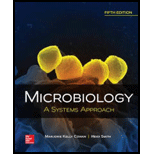
Microbiology: A Systems Approach
5th Edition
ISBN: 9781259706615
Author: Marjorie Kelly Cowan Professor
Publisher: McGraw-Hill Education
expand_more
expand_more
format_list_bulleted
Concept explainers
Question
Chapter 17.1, Problem 1AYP
Summary Introduction
To enlist:
The three major categories of microbial identification.
Concept introduction:
Microbes are organisms that are not visible to naked eyes. They are cosmopolitan and are even found in extreme environments. They can be found in extremely acidic environments or alkaline environments, in extremely hot environments such as hydrothermal vents of deep sea and hot springs, in extremely freezing environments such as Antarctic ice, and also in extremely salty environments.
Expert Solution & Answer
Want to see the full answer?
Check out a sample textbook solution
Students have asked these similar questions
Limetown S1E4 Transcript: E
n 2025SP-BIO-111-PSNT1: Natu
X
Natural Selection in insects
X
+
newconnect.mheducation.com/student/todo
CA
NATURAL SELECTION NATURAL SELECTION IN INSECTS (HARDY-WEINBERG LAW)
INTRODUCTION
LABORATORY SIMULATION
A Lab Data
Is this the correct allele frequency?
Is this the correct genotype frequency?
Is this the correct phenotype frequency?
Total
1000
Phenotype Frequency
Typica
Carbonaria
Allele Frequency
9
P
635
823
968
1118
1435
Color
Initial Frequency
Light
0.25
Dark
0.75
Frequency Gs
0.02
Allele
Initial Allele Frequency
Gs Allele Frequency
d
0.50
0
D
0.50
0
Genotype Frequency
Moths
Genotype
Color
Moths
Released
Initial
Frequency
Frequency G5
Number of
Moths Gs
NC
- X
Which of the following is not a sequence-specific DNA binding protein?
1. the catabolite-activated protein
2. the trp repressor protein
3. the flowering locus C protein
4. the flowering locus D protein
5. GAL4
6. all of the above are sequence-specific DNA binding proteins
Which of the following is not a DNA binding protein?
1. the lac repressor protein
2. the catabolite activated protein
3. the trp repressor protein
4. the flowering locus C protein
5. the flowering locus D protein
6. GAL4
7. all of the above are DNA binding proteins
Chapter 17 Solutions
Microbiology: A Systems Approach
Ch. 17.1 - Prob. 1AYPCh. 17.1 - Prob. 2AYPCh. 17.1 - Prob. 3AYPCh. 17.1 - Prob. 4AYPCh. 17.2 - Summarize the most common methods used for direct...Ch. 17.2 - Prob. 6AYPCh. 17.2 - Prob. 7AYPCh. 17.3 - Prob. 8AYPCh. 17.3 - Differentiate between sensitivity and specificity.Ch. 17.3 - Explain how fluorescent antibodies can be used in...
Ch. 17.3 - Prob. 11AYPCh. 17.3 - Prob. 12AYPCh. 17.3 - Prob. 13AYPCh. 17.3 - Explain the difference between a direct and an...Ch. 17.4 - Prob. 15AYPCh. 17.4 - Prob. 16AYPCh. 17.4 - Prob. 17AYPCh. 17.5 - Prob. 18AYPCh. 17.5 - List the major advantages of microarray methods of...Ch. 17.5 - Summarize the benefits of using whole-genome...Ch. 17 - Prob. 1MCQCh. 17 - Prob. 2MCQCh. 17 - Prob. 3MCQCh. 17 - Prob. 4MCQCh. 17 - Prob. 5MCQCh. 17 - Prob. 6MCQCh. 17 - Prob. 7MCQCh. 17 - Prob. 8MCQCh. 17 - The Western blot test can be used to identify a....Ch. 17 - Prob. 10MCQCh. 17 - True-False Questions. If the statement is true,...Ch. 17 - Prob. 12TFCh. 17 - Prob. 13TFCh. 17 - Prob. 14TFCh. 17 - Prob. 15TFCh. 17 - Explain why specimens should be taken aseptically,...Ch. 17 - Prob. 2CTQCh. 17 - Explain which type of ELISA can be used to...Ch. 17 - Prob. 4CTQCh. 17 - Prob. 5CTQCh. 17 - Prob. 1VCCh. 17 - From this chapter, figure 17.14. Can you explain...Ch. 17 - Prob. 1CM
Knowledge Booster
Learn more about
Need a deep-dive on the concept behind this application? Look no further. Learn more about this topic, biology and related others by exploring similar questions and additional content below.Similar questions
- What symbolic and cultural behaviors are evident in the archaeological record and associated with Neandertals and anatomically modern humans in Europe beginning around 35,000 yBP (during the Upper Paleolithic)?arrow_forwardDescribe three cranial and postcranial features of Neanderthals skeletons that are likely adaptation to the cold climates of Upper Pleistocene Europe and explain how they are adaptations to a cold climate.arrow_forwardBiology Questionarrow_forward
- ✓ Details Draw a protein that is embedded in a membrane (a transmembrane protein), label the lipid bilayer and the protein. Identify the areas of the lipid bilayer that are hydrophobic and hydrophilic. Draw a membrane with two transporters: a proton pump transporter that uses ATP to generate a proton gradient, and a second transporter that moves glucose by secondary active transport (cartoon-like is ok). It will be important to show protons moving in the correct direction, and that the transporter that is powered by secondary active transport is logically related to the proton pump.arrow_forwarddrawing chemical structure of ATP. please draw in and label whats asked. Thank you.arrow_forwardOutline the negative feedback loop that allows us to maintain a healthy water concentration in our blood. You may use diagram if you wisharrow_forward
- Give examples of fat soluble and non-fat soluble hormonesarrow_forwardJust click view full document and register so you can see the whole document. how do i access this. following from the previous question; https://www.bartleby.com/questions-and-answers/hi-hi-with-this-unit-assessment-psy4406-tp4-report-assessment-material-case-stydu-ms-alecia-moore.-o/5e09906a-5101-4297-a8f7-49449b0bb5a7. on Google this image comes up and i have signed/ payed for the service and unable to access the full document. are you able to copy and past to this response. please see the screenshot from google page. unfortunality its not allowing me attch the image can you please show me the mathmetic calculation/ workout for the reult sectionarrow_forwardIn tabular form, differentiate between reversible and irreversible cell injury.arrow_forward
arrow_back_ios
SEE MORE QUESTIONS
arrow_forward_ios
Recommended textbooks for you
 Principles Of Radiographic Imaging: An Art And A ...Health & NutritionISBN:9781337711067Author:Richard R. Carlton, Arlene M. Adler, Vesna BalacPublisher:Cengage Learning
Principles Of Radiographic Imaging: An Art And A ...Health & NutritionISBN:9781337711067Author:Richard R. Carlton, Arlene M. Adler, Vesna BalacPublisher:Cengage Learning

Principles Of Radiographic Imaging: An Art And A ...
Health & Nutrition
ISBN:9781337711067
Author:Richard R. Carlton, Arlene M. Adler, Vesna Balac
Publisher:Cengage Learning




